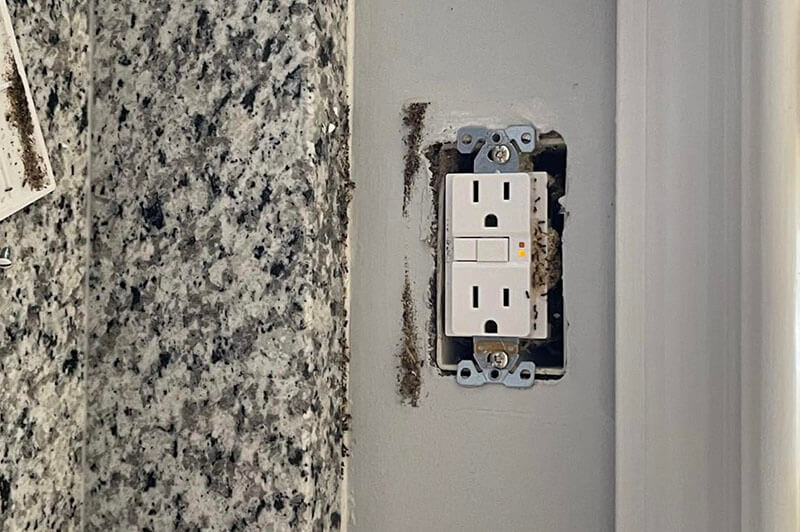Yes, GFCI outlets are required in kitchens to prevent accidents and keep you and your family safe. I have seen or experienced many of my friends and neighbors meet some accidents just because they didn’t install some GFCI outlets in their kitchen area, and all those accidents could’ve been easily prevented.
GFCI outlets are required in kitchens to prevent shock and fire, and it also works as a waterproof shield and extra layer of protection. You will need at least one outlet for each appliance you plug in or have in your kitchen.
In the later section, I discussed all the requirements and how to install them in detail. Let’s get into it!
Quick Jump
5 Benefits of GFCI Outlets in Kitchen Areas

“Safety First,” I am sure you have heard this line many times. It is complicated regarding electrical issues, especially in the kitchen. To ensure that you, your family, and your kitchen appliances are safe, using GFCI outlets in your kitchen areas is highly recommended.
And, of course, there are many benefits to it. You might know them already, but here is an overview.
Benefit #1: Shock Prevention
As you might know, the primary purpose of a GFCI is to keep your appliances safe, and for that, GFCI outlets are like your kitchen’s personal shock absorbers.
They have this superpower to detect even the tiniest electrical leakage and cut off the power faster than you can say, “Safety first!”
Benefit #2: Waterproof Shield
We all know kitchens can be messy, with water splashing around and liquids getting spilled. GFCI outlets are like magical waterproof shields for your electrical circuits.
They sense when water decides to play with electricity and immediately shut things down before any harm is done. No more shocking surprises while reaching for that stray noodle.
Benefit #3: Fire Prevention
A faulty electrical appliance in your kitchen might start acting up, and decides to throw a party with sparks and smoke. No one likes that.
Here is what a GFCI comes in handy as they can detect abnormal electrical currents and help prevent overheating and reduce the risk of electrical fires.
Benefit #4: Code Compliance
No matter where you live, your area always has code compliance. Building regulations often require GFCI outlets in specific areas, such as near sinks and countertop surfaces.
By installing them, you can ensure your kitchen meets all the necessary safety standards.
Benefit #5: Extra Layer of Protection
If I’m being honest, I wasn’t up to spending my bucks on these things, but as soon as I learned about GFCI’s benefits and what could happen If I didn’t have these, I hustled because it changed my mind.
They provide that extra layer of protection, giving me peace of mind while you whip up culinary masterpieces or make that late-night snack run.
But remember that, as they are benefits of having a GFCI, these things also can become a nightmare if you don’t have them.
I hope you have fixed your mind on installing them.
Requirements for GFCI Outlets in Kitchen Areas
I will tell you exactly how many GFCI outlets you will need for all your kitchen appliances, but before that, I should discuss all the requirements for GFCI outlets in your kitchen area.
Rather than go into too many details, there is a table to help you understand.
| Requirement | Detail |
| Countertop Outlets | Required for all electrical outlets located on or near kitchen countertops |
| Sink | Any outlet located within 6 feet of a sink, regardless of whether it’s a countertop outlet or not |
| Multiple Outlets | Need to be wired in a seriesThe first outlet in the circuit needs to be a GFCI outlet, while the subsequent outlets can be standard ones |
| NEC Compliance | A standard followed in the United StatesIt might vary from area to area |
| Dishwasher and Garbage Disposal Outlets | Local codes may allow these outlets to be on separate non-GFCI circuits |
| Refrigerator Outlets | If the fridge has a dedicated outlet, it does not necessarily need GFCI protection. |
That’s not everything, but you get the idea. Some codes or regulations might vary from your local area, so you might consider discussing this with a professional or letting us know about it.
What Kitchen Appliances Require GFCI?
Now that you know the requirements, I made another table of all the kitchen appliances that need at least one GFCI outlet.
Ensure and double-check before doing the electric work, but it’s a rule of thumb that you might need at least one outlet for these appliances.
| Kitchen Appliance | Required Number of Outlets |
| Refrigerator | 1 |
| Range/Stove | 1 (dedicated circuit) |
| Dishwasher | 1 (dedicated circuit) |
| Microwave Oven | 1 (dedicated circuit) |
| Garbage Disposal | 1 |
| Toaster | 1 |
| Blender | 1 |
| Coffee Maker | 1 |
| Electric Kettle | 1 |
| Stand Mixer | 1 |
| Electric Grill | 1 |
| Electric Can Opener | 1 |
| Waffle Maker | 1 |
| Rice Cooker | 1 |
| Electric Fryer | 1 |
| Ice Cream Maker | 1 |
| Bread Maker | 1 |
| Juicer | 1 |
| Electric Steamer | 1 |
But, as you might know, it’s just a general guideline. There might be specific requirements, and they may vary based on the appliance’s power consumption and local electrical codes.
Besides, some appliances may require dedicated circuits to ensure proper electrical load management and prevent tripping breakers.
The bottom line is you will need at least one GFCI outlet for one of those appliances and if they meet the criteria or requirements.
Therefore, if it feels too complicated, please let us know. I will personally guide you.
How Do You Install a GFCI Outlet in Kitchens? (DIY)

If you’re reading this, it means you’re like me, who loves to do things independently, solve, fix, or install things. Besides, whatever the reason, sometimes it’s better to have ideas about how to install them.
So, I will go through all the necessary steps that you need to install a GFCI outlet in the kitchen.
But, before that, there are some tools that you might need.
- GFCI outlet (Of course)
- Screwdriver
- Needle-nose pliers
- Wire cutters
- Voltage tester
- Electrical tape
- Wire connectors
- Circuit tester
I don’t want you to get hurt, and I’m sure you don’t want that either. So, before installing the outlets, it’s necessary to turn off power to the kitchen circuit at the electrical panel by switching off the appropriate circuit breaker.
To ensure that, you can use a voltage tester to double-check that no power is running to the outlet.
Now, there might be some existing outlets, and you must remove them. You should unscrew the faceplate and the outlet from the electrical box. But ensure that the wires are still accessible.
I can move to the primary steps if you’re done with that.
- First, locate the black (hot), white (neutral), and bare copper (ground) wires connected to the existing outlet.
- After that, connect the bare copper (ground) wire to the green grounding screw on the GFCI outlet.
- Connect the white (neutral) wire to the silver screw and the black (hot) wire to the brass screw terminal marked “LINE” on the GFCI outlet.
- After that, ensure all wires are securely connected and tightened.
- If you’re done with that, use screws to secure the outlet to the box, ensuring it is firmly in place.
That’s it! You’re done. Now, turn the power back on at the electrical panel and use a circuit tester or plug in a device to ensure the GFCI outlet functions correctly.
If you press the “RESET” button to restore power, we’re almost done. And attach the faceplate to the GFCI outlet using the provided screws.
3 Alternatives to GFCI Outlets in Kitchen
If you don’t want to spend your bucks on the GFCI anymore and want to know if there are other alternatives you might have in your home, the answer is yes, there are.
Here are some alternatives you might want to explore.
Alternative #1: GFCI Circuit Breakers
- A single GFCI circuit breaker can protect multiple outlets.
- It eliminates the need for purchasing and installing multiple GFCI outlets.
- Help save space in electrical panels.
- A code-compliant alternative to GFCI outlets.
Alternative #2: AFCI Outlets
- Specifically designed to detect and mitigate the risk of electrical fires caused by arc faults.
- Primarily focused on protecting against electrical shocks, AFCI outlets protect against fire hazards.
- AFCI outlets are required by electrical codes for specific areas, including kitchens.
Alternative #3: AFCI-GFCI Combination Outlets
- Beneficial if you have limited space on your electrical panel or in your kitchen area.
- It can be more cost-effective.
- By combining AFCI and GFCI functionality in one outlet, you benefit from both ground fault and arc fault protection.
- AFCI-GFCI combination outlets can be a convenient retrofit option.
Wrap Up
I’ve shared everything I know about using GFCI outlets in your kitchen area. And, yes, you will need GFCI outlets as many as the number of the appliance you have and if they meet the criteria and requirements.
If you still have some confusion, you can consult with a professional or let me know about your query, and I will get back to you. Have a great day!

Chino is an accomplished Founder and Home Improvement Contractor with a passion for transforming living spaces into beautiful, functional, and comfortable homes. With years of experience in the industry, he has established himself as a reputable expert in the field, earning the trust and admiration of numerous clients.
